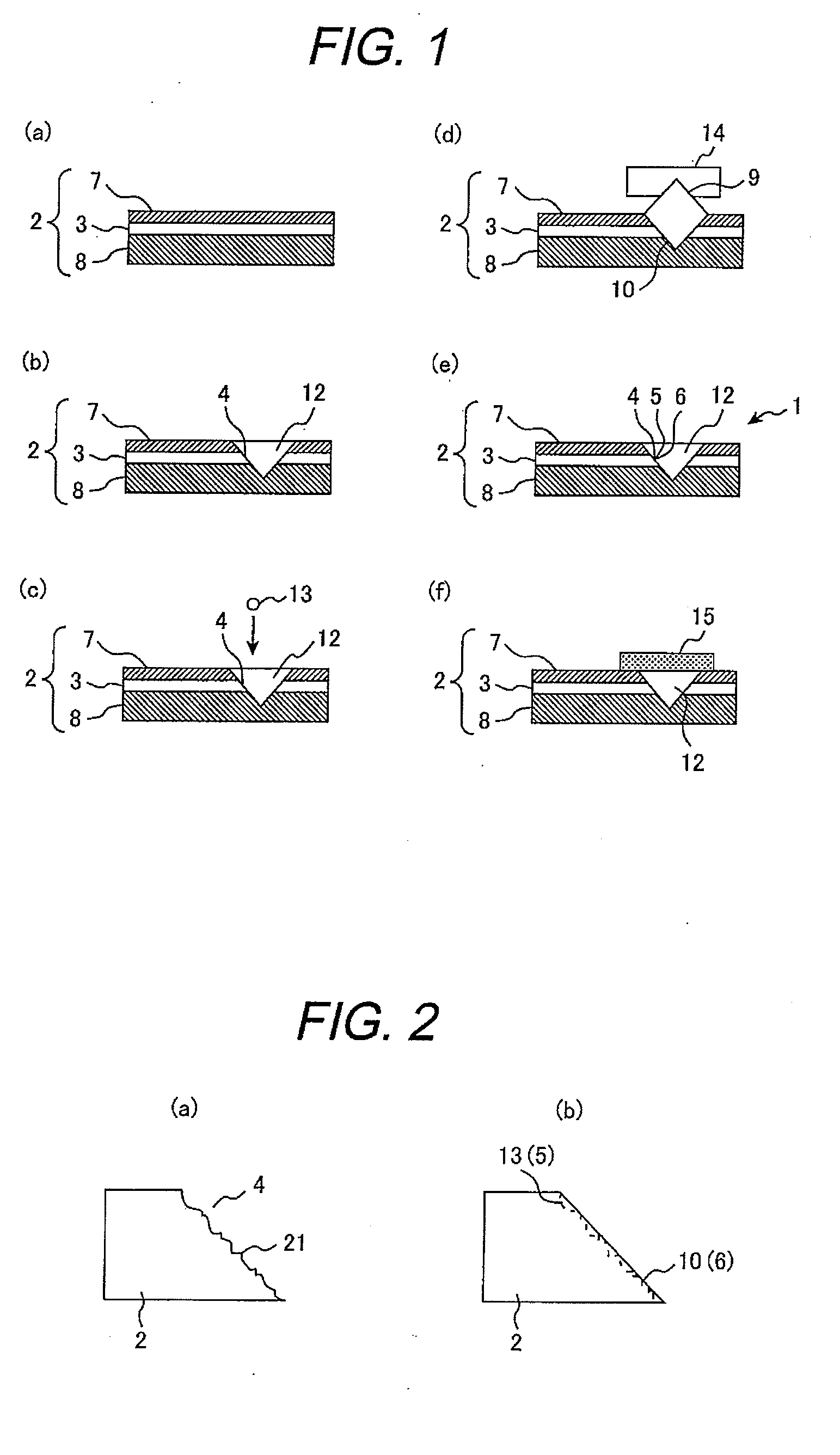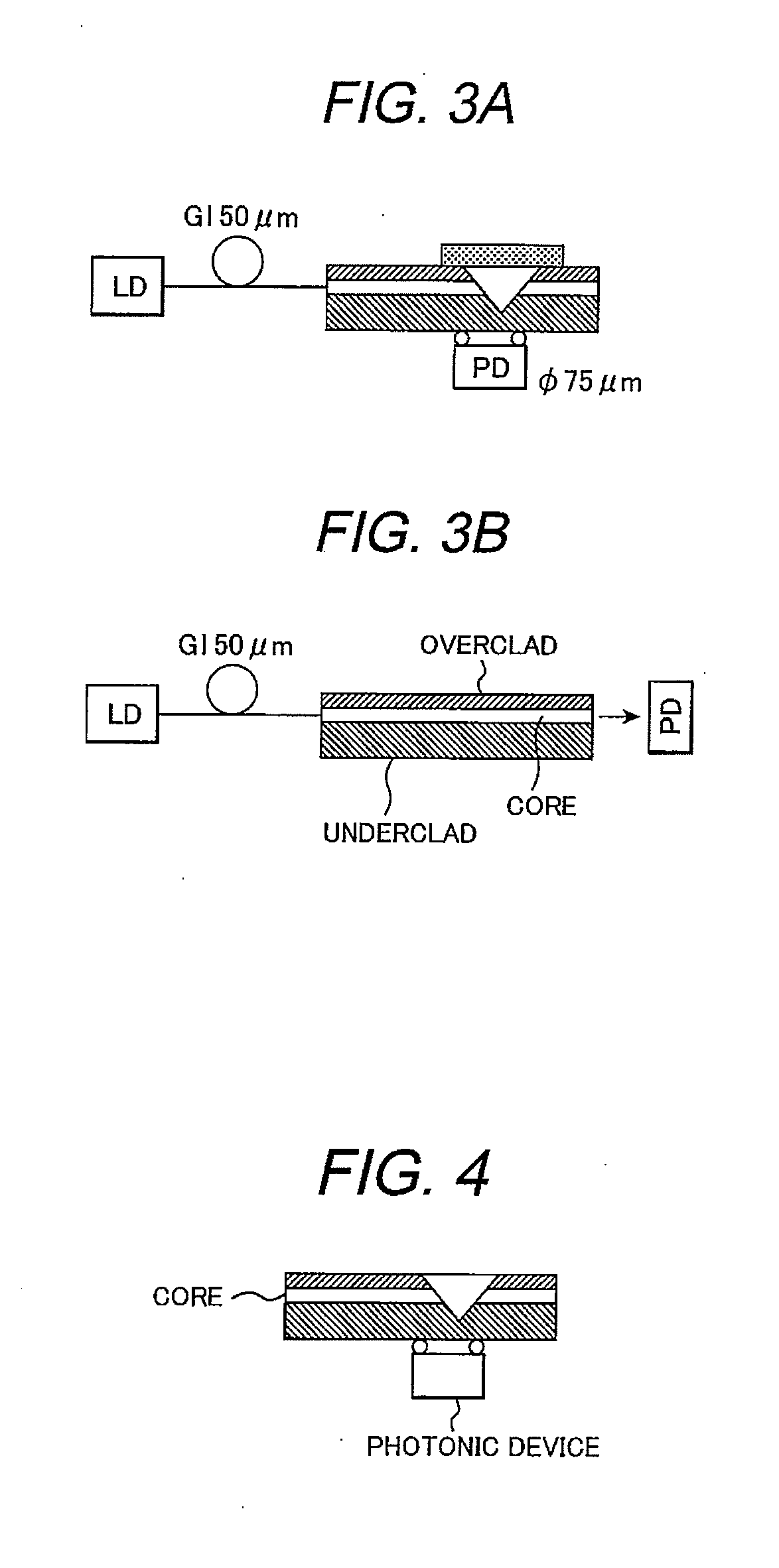Mirror-Embedded Optical Waveguide and Fabrication Method of Same
a technology of optical waveguides and fabrication methods, applied in optical waveguide light guides, instruments, optics, etc., can solve the problems of increased light reflection loss, degraded reflection efficiency, and cost problems of mirrors provided by metal-deposited surfaces, and achieve excellent optical characteristics and reliability, and advantages in cost and mass production
- Summary
- Abstract
- Description
- Claims
- Application Information
AI Technical Summary
Benefits of technology
Problems solved by technology
Method used
Image
Examples
example 1
[0047]At first, in order to fabricate a mirror groove, a V-groove having cut faces angled 45° with respect to the axis of a photonic device was formed in an epoxy-based polymer optical waveguide [refractive index: 1.57 (core); 1.51 (clad)] using a dicing blade with two cutting faces forming a 90° angle. The structure of the epoxy-based polymer optical waveguide was as follows: core thickness 50 μm, underclad thickness 50 μm, overclad thickness 20 μm, without substrate.
[0048]Then, a metal-layer-transferring-jig was fabricated using a square column of silicon with smooth surfaces having a roughness Ra of 0.02 μm or less. Subsequently, a 0.3-μm-thick gold layer was vapor deposited onto the jig. Next, onto the core area of the mirror groove, there was dropped, with a dispenser, a thermosetting epoxy-based adhesive having the same refractive index as that of the core (1.57). Then, the metal-layer-transferring-jig was fitted into the mirror groove so that its gold deposited surface contac...
example 2
[0054]Another mirror-embedded-optical-waveguide as Example 2 was fabricated. In Example 2, a thermosetting epoxy-based adhesive having the refractive index of 1.52 was used, which was approximately the same refractive index as that of the core (1.57). The other fabrication conditions as well as the measurement were the same as those of Example 1.
[0055]The result of the measurement was that the light reflection loss (mirror loss) of Example 2 was as low as 0.7 dB, which was almost the same level in Example 1. In addition, there was observed no degradation in the light reflection loss (mirror loss) even after the high-temperature-and-high-humidity test (85° C. and 85% RH for 1,000 h) and after the thermal shock test (from −40° C. to 85° C., 500 cycles).
example 3
[0056]Another mirror-embedded-optical-waveguide as Example 3 was fabricated. In Example 3, a thermosetting epoxy-based adhesive having the refractive index of 1.60 was used, which was approximately the same refractive index as that of the core (1.57). The other fabrication conditions as well as the measurement were the same as those of Example 1.
[0057]The result of the measurement was that the light reflection loss (mirror loss) of Example 3 was as low as 0.6 dB, which was almost the same level in Example 1. In addition, there was also observed no degradation in the light reflection loss (mirror loss) even after the high-temperature-and-high-humidity test (85° C. and 85% RH for 1,000 h) and after the thermal shock test (from −40° C. to 85° C., 500 cycles).
PUM
 Login to View More
Login to View More Abstract
Description
Claims
Application Information
 Login to View More
Login to View More - R&D
- Intellectual Property
- Life Sciences
- Materials
- Tech Scout
- Unparalleled Data Quality
- Higher Quality Content
- 60% Fewer Hallucinations
Browse by: Latest US Patents, China's latest patents, Technical Efficacy Thesaurus, Application Domain, Technology Topic, Popular Technical Reports.
© 2025 PatSnap. All rights reserved.Legal|Privacy policy|Modern Slavery Act Transparency Statement|Sitemap|About US| Contact US: help@patsnap.com



